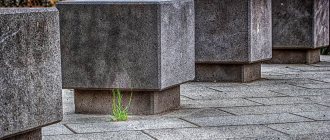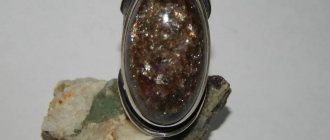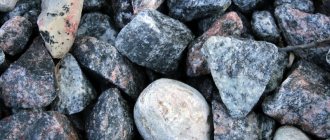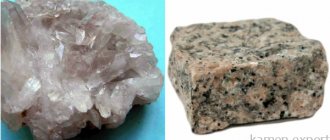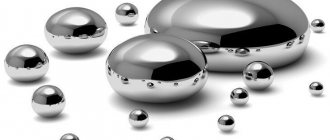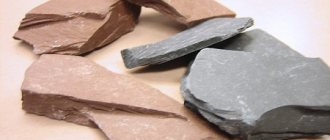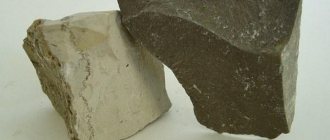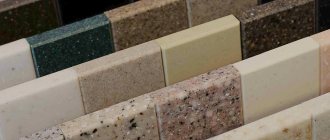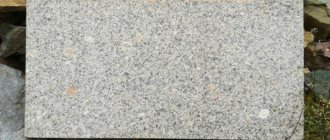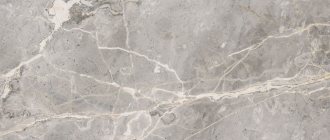- Reports and messages
- Miscellaneous
- Granite mineral
Granite is very popular among durable natural rocks in nature.
This mineral was formed from molten magma in the very depths of the earth. Granite is based on mica, feldspar and quartz rocks. Its color can be quite varied. The most common granite in nature, which is well used by humans, is gray granite. You can also find pink, red and orange granite. Due to the diversity of earth rocks that make up this fossil, in different parts of our Earth, its color will differ. Granite only forms at great depths underground. In this place, the igneous alloy cools well, subsequently forming granite rock. Granite itself is a stone that is one of the oldest stones on Earth. Scientists have found that granite is found only on our planet. Since granite is a fairly durable building material, it was used by medieval builders. Monumental structures were erected from it, and tombs were built. Today, this material has not lost its significance; it is used to decorate squares, buildings, stairs and much more. Granite is found everywhere, mined and used. Many countries are engaged in its extraction. In the USA, granite deposits are found along the Atlantic coast. In Russia it is mined in many regions of the country. Ukraine has one of the largest granite deposits. A crystalline shield stretches across the entire territory of the country. Granite as a material has more positive qualities than negative ones. First of all, it is quite durable and strong. It is simply an ideal building material that withstands atmospheric conditions and acids well; this stone is excellent for exterior finishing of premises and buildings. In addition, granite is waterproof, which is why embankments are laid out with it. And, probably, the most important thing is that it is quite environmentally friendly. Granite is suitable for many types of construction; it has almost no restrictions.
Just like the ancient builders, modern society cannot abandon the use of granite. Without any degree of exaggeration, it can be safely called universal. Since granite is durable, steps and stairs are laid out of it. Window sills and cornices look beautiful if they are made of granite. Facade decoration, landscape design elements, railings and wonderful embankments will look great if they are made exclusively of granite.
If granite were not so durable, unique sculptures and architectural masterpieces would hardly have survived to this day. Each variety is unique and irresistible. Most likely, people will be able to use this mineral for their own purposes for a long time.
History and origin
One lyricist in his poems associated granite with the words “edge” and “boundaries”, but the name of the stone arose from the Latin granum - “grain” . The name of the mineral was given by the Italian naturalist Caesalpinus. But the first information about the rock itself was recorded in documents from the times of Ancient Egypt and Rome. Then people used the material in the construction of fundamental structures.
Granite is often associated with strength and reliability. It makes up most of the earth's crust. There are even entire mountains made from this rock, for example, Mont Blanc. The stone is called the “calling card of the Earth” because it is not found on other planets.
Scientists give two versions of the origin of granite. Some experts believe that natural stone arose from molten magma, which slowly cooled in the earth's crust. Over time, it formed into a fossilized structure, and over many years, granite grains of various sizes crystallized in it.
Other scientists are inclined to believe that sedimentary rocks with sand and types of clay gradually shifted due to tectonic processes deep in the earth's crust. High temperatures and pressure caused the substances to melt. This process was called granitization.
Most of the world's granites are formed in collision zones. When two continental plates collide with each other, the layer of crust on the continent increases. Due to thickening, layered deposits of molten rock appear at a depth of 10−20 km. This phenomenon is called granitic magmatism.
Description of Granite report
Granite is very popular and widespread among rocks of natural origin. As a favorite material of designers, builders and architects for many millennia, its beneficial properties prove the need for frequent use.
Granite is formed thanks to two methods, one of which is associated with the gradual solidification of a hot magmatic mixture in the bowels of the earth. Thanks to this origin, it takes on the appearance of grains. This method of forming volcanic rock is widespread. In addition, granite can be the result of compression under high pressure of clastic, sedimentary rocks, which are subject to the movement of tectonic processes, ultimately ending up at depth. This is how the crystalline form of a rock is formed.
Depending on what stones are included in its composition and in what condition, the color characteristics may be different.
Pink and orange colors of granite indicate the presence of predominantly spar in it. Black and white material with inclusions indicates the presence of quartz. The red color indicates the presence of iron oxide. The deposits of China are known for natural stones with a green tint. Iron gives granite its brown color.
This rock occurs on every continent of the Earth, but everywhere it is unique. The structure of the stone is the same type - in the form of grains, but differs in size - from small to large, depending on the method of formation.
Due to its rich color palette, granite is in great demand for creating details in interior design. Landscape design specialists pay attention to its shine, as well as the surface that can be chosen, taking into account the customer’s desire - from smooth to rough. The great demand of granite for the construction of monuments is explained by the fact that it can be cut and easily polished.
In addition to its decorative properties, natural stone has found application in cladding facades and staircase steps due to its ability to withstand exposure to any temperature. And special processing of granite makes it possible to achieve such properties as resistance to slipping. It is frost-resistant, waterproof, and has no restrictions on use, which is why it is used in lining embankments. Cladding of houses is necessary, first of all, due to fire resistance.
Several characteristics of granite explain its widespread use in the construction industry. When compressed or during friction, its special stability is manifested. Thus, the strength of stone is always highly appreciated in the manufacture of furniture parts and countertops.
Of particular value is its safety associated with the absence of radiation and non-hazardous levels of radiation.
The retention of some properties of granite can be so long that this stone rightfully deserves a positive assessment as a durable material. Therefore, it is often used in the construction of buildings.
An interesting fact about granite is that its presence has not been proven on other existing planets.
In Russia, the granite deposit is concentrated in the Murmansk region, where blue stone is mined. Ural granite is also known, distinguished by its red tint. The Far East, Siberia and the Urals are some of the main places of its production.
3rd, 4th grade the world around us
Mining locations
Granite is common on all continents of our planet. In the USA, the rock is found along the Atlantic coast, in the northern part of the country, the central part of the Ozark Plateau, and the Black Hills. The mineral is mainly mined in Vermont, Wisconsin, Georgia and South Dakota. In Europe, large volumes of the breed can be found in Germany, Italy, Spain, Portugal and the UK.
The stone is also common in Russia. Large granite deposits are located in the Urals, the Caucasus, the Far East, as well as in Eastern Siberia and the Karelo-Kola region. There are more than 50 deposits where piece stone is mined. Granite crushed stone and rubble can be found in regions such as Prionezhye, Ladoga, Karelian Isthmus, Primorye, Eastern Transbaikalia, Khabarovsk Territory. The material is also available in the Arkhangelsk, Voronezh, Sverdlovsk and Chelyabinsk regions. The mineral with a high degree of decorative value is found in the north-west of the country.
At least 200 granite deposits are known in the post-Soviet space. The largest mineral deposits are found in Ukraine (Zaporozhye and Poltava regions) and Belarus (Brest region).
Granite is a mineral
Granite is a crystalline rock found in mountainous areas and consists of feldspar, mica and silicon oxide. The breed can be found on all continents of the planet.
Due to the crystallization of magma at different depths under the earth's crust, solid minerals of different configurations and sizes are formed. In some cases, it appears on the surface of the earth due to the destruction of the sediments that covered it.
It is a natural stone with a fine, medium or coarse grain structure. The stone has a wide range of colors and a variety of shades: black, burgundy, gray, white and with various inclusions. The shade depends on the percentage of minerals contained in granite.
Throughout Russia, there are up to 50 places where granite is formed, which is used as a piece stone. The largest deposit of beautiful stone was discovered in Ukraine.
Advantages of granite.
1. High-quality granite with fine grain is durable and does not undergo destruction for 500 years.
2. Resistant to abrasion, friction and compression. The stone has a density of 2.6-2.7 t/m, and a strength of up to 250 MPa.
3. Granite is not affected by weather conditions and acids. Excellent for finishing the exterior surface of a building.
4. Waterproof. The material does not absorb moisture and is suitable for use in the construction of embankments.
5. Radiation-safe and environmentally friendly stone.
6. Variety of textures.
7. Good compatibility with other construction, finishing and decorative materials that fit perfectly into all design solutions.
8. Large range of colors. The most common granite is gray, less common are red, pink, orange and green.
Granite is a universal material and is widely used in construction:
— floors on staircases, thanks to their abrasion resistance;
— window sills, cornices, countertops, columns, railings are not subject to mechanical damage due to the increased strength properties of the stone;
— a variety of textures for finishing the facade and interior;
— landscape design details;
— bridge supports, steps and paving stones;
— stone does not absorb moisture and is used for finishing embankments.
Rock composition
The mineral belongs to the class of igneous rocks. It is presented in the form of crystals with a granular structure. The diagram reflects the three main substances that make up granite:
- feldspar - 60−65%;
- quartz - 25−35%;
- mica (biotite) - 5−10%.
The color of the stone depends on the volume of spar. More often you can find pink, red, gray and black minerals. Rare samples have blue or green shades. The amount of quartz affects the translucency of the grain. The more biotite a mineral contains, the more shimmer it shows when the viewing angle changes. Granite consists not only of aluminum, iron, silicon, potassium, calcium, manganese, hydrogen, oxygen and sodium. The chemical formula of different stones may include such minor elements as tungsten, lithium, titanium, chromium, etc.
Geochemical classifications of granites
Widely known abroad is the classification of Chappell and White, continued and supplemented by Collins and Valen.
It contains 4 types of granitoids: S-, I-, M-, A-granites. In 1974, Chappell and White introduced the concepts of S- and I-granites, based on the idea that the composition of granites reflects the material of their source.
Subsequent classifications also generally adhere to this principle.
S - (sedimentary) - melting products of metasedimentary substrates, I - (igneous) - melting products of metamagmatic substrates, M - (mantle) - differentiated tholeiitic-basaltic magmas, A - (anorogenic) - melting products of lower crustal granulites or differentiated alkali-basaltoid magmas .
The difference in the composition of the sources of S- and I-granites is established by their geochemistry, mineralogy and composition of inclusions.
The difference in sources also suggests a difference in the levels of melt generation: S - supracrustal upper crustal level, I - infracrustal deeper and often more mafic.
Geochemically, S- and I have similar contents of most petrogenic and rare elements, but there are also significant differences. S-granites are relatively depleted in CaO, Na2O, and Sr, but have higher concentrations of K2O and Rb than I-granites. These differences are due to the fact that the source of S-granites went through a stage of weathering and sedimentary differentiation. The M type includes granitoids that are the final differentiated of tholeiitic-basaltic magma or a product of melting of a metatoleiitic source.
They are widely known as oceanic plagiogranites and are characteristic of modern MOR zones and ancient ophiolites. The concept of A-granites was introduced by Eby. They showed that they vary in composition from subalkaline quartz syenites to alkaline granites with alkaline masons, and are sharply enriched in incoherent elements, especially HFSE.
According to the conditions of education, they can be divided into two groups. The first, characteristic of oceanic islands and continental rifts, is a product of differentiation of alkali-basaltic magma.
The second includes intraplate plutons that are not directly related to rifting, but are confined to hot spots. The origin of this group is associated with the melting of the lower parts of the continental crust under the influence of an additional heat source.
It has been experimentally shown that when melting tonalite gneisses at P = 10 kbar, a melt enriched in fluorine is formed in petrogenic components, similar to A-granites and granulite (pyroxene-containing) restite.
Physical properties
One of the most important properties of granite is its strength. The smaller the grain size in the stone, the higher this indicator. This mineral is twice as strong as marble.
The stone is divided into three groups:
- Fine-grained. The grain size is less than 2 mm. Such minerals are characterized by a high degree of strength, resistance to destruction and water resistance. They are considered the most expensive and in demand due to their high quality.
- Medium grain. The grain size varies between 2−5 mm. The characteristics of this type are slightly worse than the previous one, but it is also often used in construction.
- Coarse-grained. Grains exceeding 5 mm make the material less fire resistant. At temperatures above 600 °C the stone is damaged and increases in volume.
The density of the rock is 2600 kg/m3, Mohs hardness is 5-7. Melting point - 1215−1260°C; in the presence of water and pressure it can drop to 650 °C. The average specific gravity of stone is 2700−3000 kg/m2. Granite is characterized by low water absorption and low abrasion coefficient. The stone is quite easy to process and polish , after which it retains its mirror surface for a long period. The mineral can also be carved. It can be given any shape.
The stone retains its characteristics even in the harshest environmental conditions. Granite is considered an environmentally friendly and ergonomic material. Any variety of this rock is safe for people and animals. Rock does not emit radiation. There are no restrictions on the use of granite in construction work.
Some types of stone can be given a decorative texture only after heat treatment. This is usually necessary for materials of light gray shades, which after finishing work become almost sugar-white.
Color and pattern
The most popular is red or bright pink Leznikovsky granite. There are other varieties of stone that are named after their deposits, for example, the Korninsky, Sofievsky or Zhezhelevsky gray mineral.
Amazonite granite is considered to be a beautiful granite with a green or turquoise hue. Their color is due to the green feldspar contained in the rock. No less attractive are samples of amethyst color with a lilac-pink tint. The rarest type of stone is specimens with blue quartz. In some places you can find black granite. Minerals are also found in white color. Such samples look like marble. The stone can be not only snow-white, but also shades such as light green, pearlescent or pale yellow.
The pattern of granite depends on the accumulations of dark-colored inclusions. Minerals commonly found in nature have a spotted or speckled pattern. Some samples have striped-wavy patterns. Occasionally you can find granite with a pattern resembling circles or chains. A dotted pattern is formed on the rock if it contains inclusions of flat-shaped spar crystals.
Fixing the error
There is an opinion that granite belongs to sedimentary rocks. This gross error is associated with the surrounding of granite massifs by sedimentary rocks - limestones, clays, sandstones.
When hot granitic magma intrudes into rocks of different composition, a new banded or spotted rock called skarn is formed. The most powerful skarn zones are formed in limestones, where brown garnets and needles of dark minerals of calcium, magnesium, and iron appear. The limestone is partially transformed into marble.
This is the most valuable variety of skarns, as it is accompanied by iron ores (Mount Magnitnaya, Blagodat, Ural), tungsten and molybdenum (Tyrnyauz, North Caucasus).
Rice. 3. Skarn.
When preparing for lessons on the outside world in 2nd grade, it is important to understand what granite is and not confuse it with sedimentary rocks.
Other varieties
There are many classifications of stone according to different criteria. Based on the nature and content of dark-colored inclusions, granite is divided into the following types:
- Alaska. Does not contain dark inclusions.
- Biotite. The volume of biotite in the mineral varies between 6−8%.
- Leucogranite. Low level of dark-colored particles.
- Double mica. Such minerals include biotite and muscovite.
- Lithium fluoride. The stone contains lithium micas.
- Pyroxene. The composition contains augite, quartz and orthoclase.
- Alkaline. Characterized by the presence of alkaline components.
Granite is also classified according to its grain structure. Porphyry-like stone is distinguished by brightly defined long inserts that protrude from the main mass of the rock. Pegmatoid granite is characterized by a symmetrical and uniform grain pattern. Finnish rapakivi stone is characterized by rounded inserts with a gray or greenish frame. The gneiss-like mineral has a fine-grained structure.
Areas of application
Durable rock has been used in architecture since ancient times. Not all people know that the Egyptian pyramids were built using granite. Many structures were built in Ancient Rome and India. The stone, which is characterized by durability, can withstand any climatic conditions. He is not afraid of either wind or rain.
Today, granite is used to make not only various buildings, but also stairs, steps, curbs, and street tiles. The mineral is used in the construction of monuments, sculptures, vases, columns, bridges, benches, artificial reservoirs and other architectural objects. Natural material is often used to create countertops.
The excellent performance characteristics of granite allow it to be used not only for external, but also for internal work. It is used for cladding walls and floors in a house or apartment. Any product made from a reliable building material is easy to use. No complex maintenance is required to maintain the finish in its original form.
When people decide to choose granite for finishing their home, they often doubt the choice of the appropriate stone option. Among the large variety of species, it is difficult to determine which material is considered the best. The choice of mineral depends on the purpose of its use. It should be mentioned that liquid granite, which can replace cement, is a new prospect in construction.
The stone looks harmonious in combination with marble. Items with a combination of these materials look attractive and majestic. And sometimes white granite can replace marble, which it is very similar to after proper processing. Since stone is more durable than marble, during use it does not lose its original shade, structure, or texture. Granite has only one drawback: it has the greatest weight among building materials, which must be taken into account when constructing bridges, monolithic houses and other large structures.
